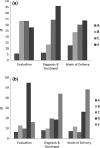Royal College of Obstetricians and Gynaecologists guidelines: how evidence-based are they?
- PMID: 24922406
- PMCID: PMC4245184
- DOI: 10.3109/01443615.2014.920794
Royal College of Obstetricians and Gynaecologists guidelines: how evidence-based are they?
Abstract
Evidence-based medicine aims to translate scientific research into good medical practice. The Royal College of Obstetricians and Gynaecologists publishes recommendations and guidelines to guide clinicians in decision-making. In this study, the evidence base underlying the 'Green-top Guidelines' has been analysed in order to establish the quality of research underlying recommendations. During this descriptive study of 1,682 individual recommendations, the authors found that only 9-12% of the guidelines were based on the best quality (Grade A) evidence. The authors believe that this type of analysis serves to provide greater clarity for clinicians and patients using guidelines and recommendations in the field of obstetrics and gynaecology to make collaborative clinical decisions.
Keywords: Evidence-based medicine; RCOG; guidelines; gynaecology; obstetrics.
Figures






References
-
- Balsham H, Helfand M, Schunemann HJ, Oxman AD, Kunz R, Brozek J, et al. GRADE guidelines: 3. Rating the quality of evidence. Journal at Clinical Epidemiology. 2011;64:401–406. - PubMed
-
- Browman GP. Evidence-based clinical practice guideline development: principles, challenges and accountability to evidence. Journal of Surgical Oncology. 2010;101:1–2. - PubMed
-
- Charles C, Gafni A, Freeman E. The evidence-based medicine model of clinical practice: scientific teaching or belief-based preaching? Journal of Evaluation in Clinical Practice. 2011;17:597–605. - PubMed
-
- Hannah ME. Planned caesarean section verses planned vaginal birth for breech presentation at term: a randomised multicentre trial. Term Breech Trail Collaborative Group. Lancet. 2000;356:1375. - PubMed
MeSH terms
LinkOut - more resources
Full Text Sources
Other Literature Sources
